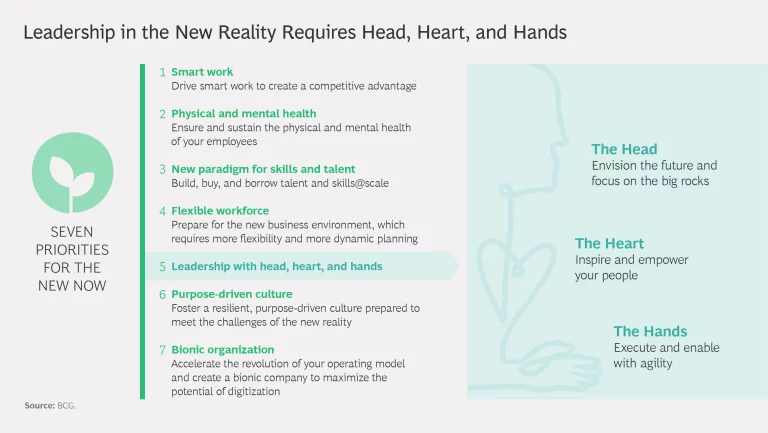The coronavirus has shaken the nature of work to its core. While many are still anxiously awaiting a return to normal, what’s “normal” after the pandemic is likely to look very different from what we were used to before it began.
As some parts of the world start to loosen restrictions, leaders need to move from crisis response to thinking about the role of organizations and leadership in the longer term. The transition will be gradual and uneven. While many are now talking about the “new normal,” this idea fails to capture the speed of the often nonlinear changes each of us is experiencing in our professional lives. As economies slowly recover, the threat of renewed waves of coronavirus remains. Uncertainty will stay with us for many months, so it will be almost impossible to define what’s “normal.” What we need to think about is not a “new normal” but a new reality—a “new now.”
For leaders, the challenge of guiding people through uncertainty and into the new reality brings timeless needs into sharper focus. Empathy and flexibility are important leadership qualities at any time. When employees experience sudden and radical change—such as the need to work remotely or in highly restricted workspaces for an extended period—these qualities are even more essential in order to keep teams cohesive, engaged, and motivated.
In a recent publication, we have detailed critical people priorities for the new now . Here we focus on one of those priorities—leadership that unites empathy and adaptability by bringing together the three essential elements of head, heart, and hands .
Seven People Priorities Beyond the Crisis
Change always presents opportunities to organizations that are open to it and able to respond nimbly. Navigating this change all comes down to people, of course. To offer a comprehensive vision of how companies can adapt to this rapidly unfolding reality, we’ve detailed critical people priorities:
- During the crisis, we see an accelerated adoption of smart work (such as remote work, travel reduction, and virtual meetings). In the new now, smart work will be the standard across organizations.
- During the crisis, most companies implement effective measures to bring health and hygiene to the next level. In the new reality, employees’ physical and mental health will be organizational cornerstones.
- During the crisis, organizations do a lot to mitigate people risks. In the new reality, a new paradigm for skills and talent will emerge.
- During the crisis, we try to manage workforce flexibility. In the new now, we will have a flexible workforce.
- During the crisis, we communicate openly with empathy. In the new now, leadership will come from the head, heart, and hands—the focus of our discussion here.
- During the crisis, organizations endeavor to stand together with employees and society. In the new now, this momentum will lead to purpose-driven culture.
- During the crisis, companies drive their digital readiness. In the new now, the bionic organization will emerge with a new operating model and robust digital backbone.
Leadership with Head, Heart, and Hands
Successful organizations will depend on leaders who are as empathetic as they are capable. Technological change makes our world a fast-paced one on any given day, and unexpected circumstances (like a pandemic) force companies and teams to adapt at lightning speed.
While the crisis is frightening and tragic, it also offers valuable lessons. What we learn today about ways of working will be invaluable for years to come, so it is up to leaders to rise to the occasion. Whether they do is a deciding factor in which companies emerge from this crisis stronger than before.
To hone their empathy and ability to adapt, leaders require three elements (see the exhibit):
- The head, to envision the future and the priorities required to succeed.
- The heart, to inspire and empower employees.
- The hands, to ensure innovative and agile-execution capabilities.
The Head
As uncertainty reigns supreme, the responsibility of leaders to craft vivid visions of the future and to lay out a clear path to success becomes more important than ever.
Microsoft excels at creating an aspirational vision that helps guide everything from the company’s overarching strategy down to individual employees’ actions and motivation. In an email to employees in March, when the full scope of this crisis was starting to become clear, CEO Satya Nadella wrote to employees to share his vision, explaining that “during this extraordinary time, it is clear that software, as the most malleable tool ever created, has a huge role to play across every industry and around the world.”
The vision Nadella laid out is at once steadfast and flexible. He went on to describe how Microsoft’s tools are being used in telemedicine, in e-learning for students forced to stay at home, in remote work, and for cybersecurity at a time when workers are rapidly adopting new digital tools. The proof is in the pudding: in China, the company has seen a 500% increase in Microsoft Teams meetings, calling, and conferencing.
The lesson for the new now is clear: a powerful vision will help people thrive in their work—not only at disruptive technology startups that routinely set their sights on changing the world but at businesses everywhere. To remain relevant in a shifting environment, visions should be frequently revisited and carefully guarded.
The Heart
In 2019, the Business Roundtable, an organization of US CEOs, declared that businesses need to do more than generate profits. They need a purpose that serves society at large, from customers and employees to suppliers, communities, and shareholders. While 181 CEOs signed the statement, some perceived the declaration as mere lip service, and few tangible changes ensued.
Just months later, the idea of purpose has never been more crucial. Companies from a broad range of industries have started pitching in to find ways to turn the tide of the pandemic. Nike, LVMH, and many others are shifting their production from sportswear and luxury accessories to protective equipment and disinfectant—adopting strategic business moves that incorporate key elements of social impact and corporate citizenship.
The crisis is shining a bright light on corporate culture.
The crisis is shining a bright light on corporate culture. It is revealing whether businesses support their workforce, for example, through the promise of avoiding layoffs and doing what they can to minimize financial hardship, or whether employees feel that protecting the bottom line is priority number one.
Before the coronavirus, the heart was one of the most ignored elements of leadership . Research shows that only one in four leaders has high empathy skills, and a study conducted at the University of Michigan showed a 34% to 48% decline in skills related to empathy over an eight-year period. This is a worrying development, given that empathy helps build strong relationships between local and remote workers while motivating teams and driving performance.
Now is the time for companies to create a more empathetic culture. Of course, a culture is credible only if it lives up to its promise through good and bad times alike.
The Hands
A purpose can inspire people, but it is only one of several puzzle pieces that help them succeed. Purpose can serve as a North Star, but navigating the day-to-day takes robust two-way communication between employees and leaders, be it in the office or from two different kitchen tables.
While the command-and-control model, which implicitly rests on one-way communication, has worked reasonably well in stable environments, it is ineffective at addressing recent years’ exponential increase in business Bringing Managers Back to Work , particularly in unstable times. Managers don’t just need to frame issues; they must also solicit feedback and suggestions, and regularly interact with teams as “thought partners.”
Global leaders have long understood the challenge of bringing together teams that work in different locations. Based on the idea that some of the most insightful, conversations happen in a kitchen, German industrial giant Siemens solved this problem by creating a “virtual café” for its global HR team. In this digital space, team members from all corners of the world can meet, find out new information, and share questions and ideas. This informal space has built a sense of belonging and engagement, in turn creating a truly collaborative, global team.
Many companies that had not previously found good solutions to the challenge of a dispersed workforce now have a much greater incentive to do so.
Many companies that had not previously found good solutions to the challenge of a dispersed workforce now have a much greater incentive to do so. The challenge for leaders in the new now is to give direction, provide autonomy, and focus on outcomes rather than activities—especially as work continues to become more flexible and distributed.
Benefits to Leading with the Head, Heart, and Hands
The benefits of combining a vision with strong practical leadership skills and deep empathy may seem difficult to quantify, and the effort required hard to justify. But our work with clients suggests that the numbers speak for themselves. Around the world, companies that are bringing together the head, heart, and hands are seeing gains even in turbulent times, while also building their competitive advantage for the future.
Crises like the one we are facing today force businesses and their leaders to change and adapt at extraordinary speed. Those that can filter out the noise and focus on what truly drives success, leading with head, heart, and hands, will emerge stronger than ever.










